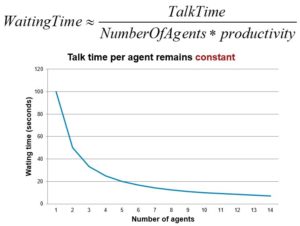With new technologies such as Chatbots, Co-browsing and screen sharing, companies at times embark on new interaction channels without taking into account the existing contact center. This blog describes the disadvantages of not integrating.
- The Erlang C formula tells us that having a small group of agents (one group for chat, one group for voice) serving one media only will result in long waiting times and low productivity.
- If we don’t use the legacy infrastructure of the contactcenter, we are forgoing many acquired benefits, resulting in a administrative overhead (agent management, skills definition, reports,…)
It is ok to start small POC’s and pilots with new channels, but such channels will become genuinely profitable only when they are fully integrated with a contact center.
Erlang C
The Erlang C formula suggests two things for customer care:
- Group agents and contact centers together wherever possible. Small units will always result in low productivity and long waiting times.
- Even small decreases in processing time will reduce waiting time and increase productivity.
=> Almost all contact center technologies are working on either one of these two points to improve customer service.
The Erlang C formula (Wikipedia) says that the waiting time for customers decreases proportionally with the number of agents and productivity of agents, and increases proportionally to the handle time.
The graphic below shows the waiting time for a customer with the productivity per agent (number of minutes per hour in talking state) being constant. One can see that the waiting time decreases proportionally to the number of agents working in parallel, given a certain agent productivity:

Intuitively, one road with four lanes will be able to handle more traffic than four roads with one lane each:

It is also the reason why we started seeing single queues for example in post offices, rather than one queue per counter. Having a single queue (aka “Single Media Routing Domain”) improves customer service.
Legacy call center environment
Customer care centers have a rich technical legacy and are highly optimized in their processes with specialized software to handle customer requests, such as
- Agent Identities and Skill sets
- Media Routing/ Call Distribution (ACD) strategies
- Business Intelligence (BI) and reporting
- Workforce Management (WFM)
- Customer Relationship Management (CRM)
- Quality Assurance and agent Training (QA)
- Knowledge base (KB)
- Marketing and campaign management
- Agent guidance/ conversation guides
Customers expect to be served consistently and seamlessly through various media channels, such as the Website, Voice and Video Calls, SMS, Chat (over a variety of tools such as Facebook Chat, Mobile app Chat, SMS,…), Emails, Documents and retail branches.
If a new solution is deployed that doesn’t interface well with these solutions, this means foregoing the reasons why these tools were purchased in the first place, and result in a duplication of administrative effort.
Secondly, customers will experience an inconsistent service level if they switch the service channel.
Expertflow has a large and long experience in integrating solutions to contact centers. We would be happy to assist you in integrating your new channel to the contact center on all the dimensions described above.
